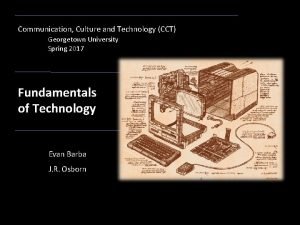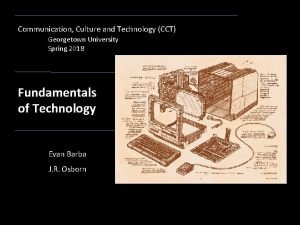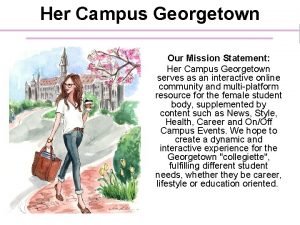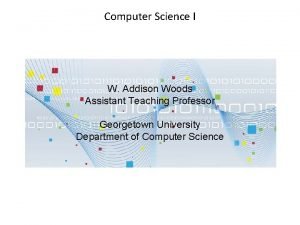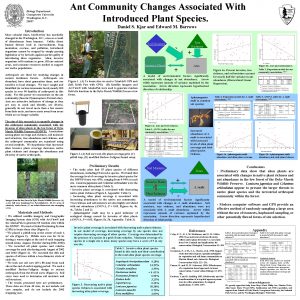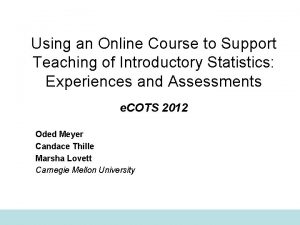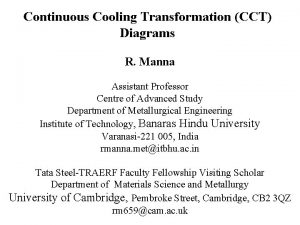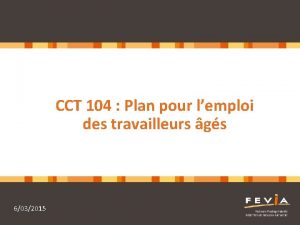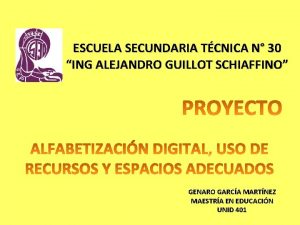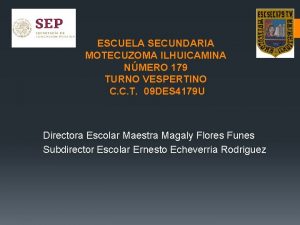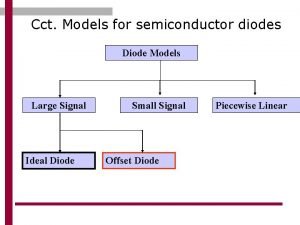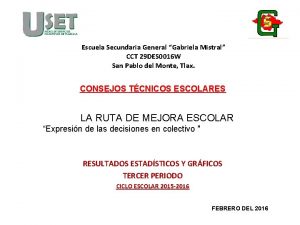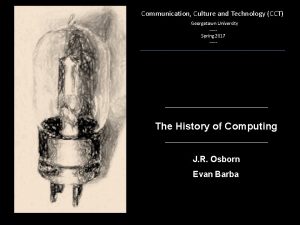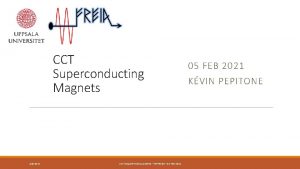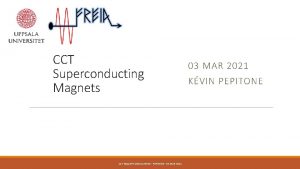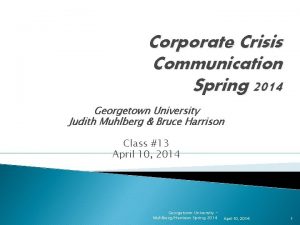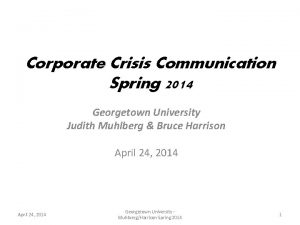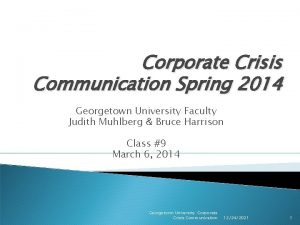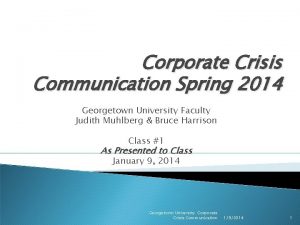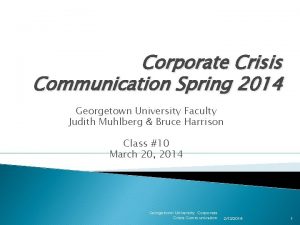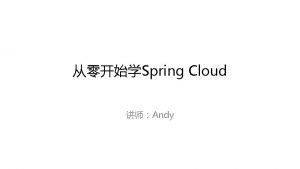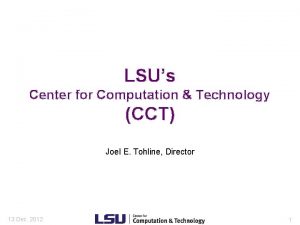Communication Culture and Technology CCT Georgetown University Spring















































- Slides: 47

Communication, Culture and Technology (CCT) Georgetown University Spring 2018 Fundamentals of Technology Evan Barba J. R. Osborn

Today Structure of the course & Key Concepts

Why fundamentals? • Change to information technology (IT) is constant and ongoing • Positioning CCT students to make a contribution to that dialogue is one goal of 506.

A man in a hot air balloon realized he was lost. He reduced altitude and spotted a woman below. He shouted, "Excuse me, can you help me? I promised a friend I would meet him an hour ago, but I don't know where I am. "

The woman below replied, "You're in a hot air balloon 30 feet above the ground. You're between 40 and 41 degrees north latitude and between 59 and 60 degrees west longitude. "

"You must be an engineer, " said the balloonist. “Everything you told me is, technically correct, but I've no idea what to make of your information, and the fact is I'm still lost. Frankly, you've not been much help at all. If anything, you've delayed my trip. "

The woman below responded, "You must be in Management. ” "I am, " replied the balloonist, "but how did you know? "

“You don't know where you are or where you're going. You have risen to where you are due to a large quantity of hot air. You made a promise which you've no idea how to keep, and you expect people beneath you to solve your problems. ”

“The fact is you are in exactly the same position you were in before we met, but now, somehow, it's my fault. "

A role for CCT students

Instructors Evan Barba JR Osborn

Teaching Assistants * all sections meet in Car Barn 318 * Kashir Aboud Grace Chimezie Wenyaun Deng Xiaoran Valentina Liu Jordan Moeny Wency Zhang Liana Sherman

Course Site: https: //blogs. commons. georgetown. edu/c ctp-506 -spring 2019/

Course Evaluation 10% – Attendance & Participation 20% – Weekly Assignments and Deliverables 30% – Exam (February 26 – In Class) 40% – Final Group Projects

Course goal: Learn how to open the blackbox of a sociotechnical system and communicate your findings to a wide audience Case study in 506: information technology

In this class we will de-black box the information and communications technologies (ICTs) that make up the computing infrastructure we rely on. To give you knowledge: Because ICTs are ubiquitous and knowing how they work is fundamental to most work in the world To model a method: Because de-black boxing can be applied to any sociotechnical system

Opening the ‘black box’

• Architecture – A specific way of organizing the flow and representation of information • Algorithm – a series of steps that move information from one state to another A blackbox is a thing that does something

e h t s ’ ? e x r e h kbo W lac b

‘De-Black Boxing’ Twitter Links Problem: Did Twitter allow someone to ”invade” Rudy Guilliani’s tweet? The Twitter box: • What are the inputs? • What are the outputs? Who/What are the actors?

• Architecture – A specific way of organizing the flow and representation of information • Algorithm – a series of steps that move information from one state to another A blackbox is a thing that does something

• Architecture? • A specific way of organizing the flow and representation of information • Algorithm? • A series of steps that move information from one state to another A blackbox is a thing that does something

Every blackbox is a “Sociotechnical System” The “systems approach” – Define the system – Describe the interactions of components – Elaborate connections to the environment

What tools do you need to open a black box? only a small number of these are specialized • How the Facebook algorithm works, for example. The rest are transferrable skills that can be applied to any black box These skills are what you will practice in this class (Framework for 21 st Century Learning)

Sociotechnical System

Sociotechnical System

Sociotechnical System


“Black boxes all the way down” Deciding which boxes to open and which can stay shut is a big part of what we call “expertise”

This is one state of a sociotechnical system

Sociotechnical System

Sociotechnical System

tes n a nic Pedestrian re gu la tio u mm o c A Traffic Light A Driver re gu lat Sociotechnical System cts a istr d cellphone / es v r s se ob ulate reg The Road reg ulat ion em ion Traffic Laws bod i me nt


n la tio gu re ar Pedestrian c ss A Driver e l r ve i r d A Traffic Light re gu lat Sociotechnical System cts a istr d cellphone / es v r s se ob ulate reg The Road reg ulat ion em ion Traffic Laws bod i me nt

A Traffic Light Pedestrian Sociotechnical System ulat ion a istr d cellphone em reg cts The Road Traffic Laws bod i me nt

That gets you here https: //boing. net/2019/01/08/self-driving-tesla-knocks-over. html

n ? re gu la tio ? ? Pedestrian A ? ? ? A Traffic Light re gu lat Sociotechnical System cts a istr d cellphone / es v r s se ob ulate reg The Road reg ulat ion em ion Traffic Laws bod i me nt

Understanding systems… Understanding environment and society as a system means thinking about parts, processes, and connections.

What is a system? A system is a group of parts which are connected and work together. Systems with living and nonliving parts are called ecosystems (which is short for ecological systems). (Odum, and Brown, 1997) To help understand systems, it is helpful to draw pictures of networks that show components and relationships.

tes n a nic Pedestrian re gu la tio u mm o c A Traffic Light A Driver re gu lat Sociotechnical System cts a istr d cellphone / es v r s se ob ulate reg The Road reg ulat ion em ion Traffic Laws bod i me nt

Procedures for Drawing a Systems Model 1. Draw the frame of attention that selects the boundary This separates the system from the environment 2. Make a list of the important input pathways that cross the boundary This fleshes out the environment and provides “Context” for the system 3. Make a list of the components believed to be important These can later be grouped into sub-systems 4. Make a list of the processes believed to be important within the defined system. These define interactions and are depicted as arrows or “Flows” of materials, energy, and information

Procedures for Drawing a Systems Model If a complex diagram has resulted (> 25 symbols), redraw it to make it neat and save it as a useful inventory and summary of the input knowledge. Redraw the diagram with the same boundary definition, aggregating symbols and flows to obtain a model of the desired complexity (perhaps 6 -12 symbols). (Odum and Odum, 1996)

Procedures for Drawing a Systems Model “Develop a model to solve a particular problem, not to model the system. ” –– John Sterman

This week… • Week 1: January 15 -17 – Lecture: Black boxes and Socio-technical Systems – Readings and Videos (for lecture): • Von Bertalanffy, L. , 1968. “Introduction” in General Systems Theory • “Systems Map” and “Influence Diagram” at Welcome to T 552 Diagramming – Lab Activity: Diagramming Socio-technical Systems

This week lab’s activity: Diagramming Socio-technical Systems • What is the problem your new technology is addressing? • Who are the users and why is this new technology relevant to them? • How is your technology different from other existing technologies? • Deliverables (due next week): Socio-technical system diagram of your 505 project

This week… and next • Week 1: January 22 -24 – Lecture: Technology as Actors in Systems – Readings and Videos (for lecture): • Latour, B. (1992). “Where Are the Missing Masses? The Sociology of a Few Mundane Artifacts. ” • Bijker. W. (1989). Chapters 1 & 2 from Of Bicycles, Bakelites, and Bulbs: Toward a Theory of Sociotechnical Change (Cambridge: MIT Press) • Winner, L. (1980). “Do Artifacts Have Politics? ” – Deliverables (due in lecture): Socio-technical system diagram of your 505 project (6 -12 symbols + arrows)
 Georgetown university communication culture and technology
Georgetown university communication culture and technology Georgetown university communication culture and technology
Georgetown university communication culture and technology Georgetown university communication culture and technology
Georgetown university communication culture and technology Consumer culture theory (cct): twenty years of research
Consumer culture theory (cct): twenty years of research Georgetown mission statement
Georgetown mission statement Giduk
Giduk Fall winter spring summer months
Fall winter spring summer months Anne rosenwald georgetown
Anne rosenwald georgetown Addison woods georgetown
Addison woods georgetown Martin ravallion georgetown
Martin ravallion georgetown David edwards georgetown
David edwards georgetown Georgetown school of continuing studies reputation
Georgetown school of continuing studies reputation Georgetown biology department
Georgetown biology department Oded meyer georgetown
Oded meyer georgetown Grace hui yang
Grace hui yang Artemis kirk
Artemis kirk Georgetown mantra 4 principles
Georgetown mantra 4 principles Material culture examples
Material culture examples Continuous culture and batch culture
Continuous culture and batch culture Difference between american and indian culture
Difference between american and indian culture Stab culture and stroke culture
Stab culture and stroke culture Folk culture and popular culture venn diagram
Folk culture and popular culture venn diagram Popular culture examples
Popular culture examples Anerobic media
Anerobic media Homework due today
Homework due today Stroke culture method
Stroke culture method Lawn or carpet culture
Lawn or carpet culture Surface culture deep culture and esol
Surface culture deep culture and esol Qualiroute
Qualiroute Uomr
Uomr Cct qualiroutes
Cct qualiroutes Cct diagram for hypoeutectoid steel
Cct diagram for hypoeutectoid steel Cct 104
Cct 104 Ing alejandro guillot schiaffino biografia
Ing alejandro guillot schiaffino biografia Escuela secundaria diurna 179 motecuzoma ilhuicamina
Escuela secundaria diurna 179 motecuzoma ilhuicamina Cct de la escuela secundaria 214 carlos marx
Cct de la escuela secundaria 214 carlos marx Cct model
Cct model Cct diagram
Cct diagram Cct qualiroutes
Cct qualiroutes Escuela secundaria victor hugo 95
Escuela secundaria victor hugo 95 Ct team module 2
Ct team module 2 Cct qualiroutes
Cct qualiroutes Calibration technician training
Calibration technician training Cct
Cct Nios
Nios Cct de la escuela secundaria gabriela mistral
Cct de la escuela secundaria gabriela mistral Cct 100
Cct 100 Kreatinin
Kreatinin
